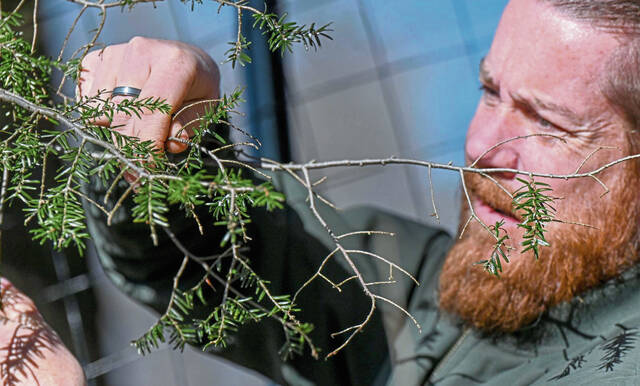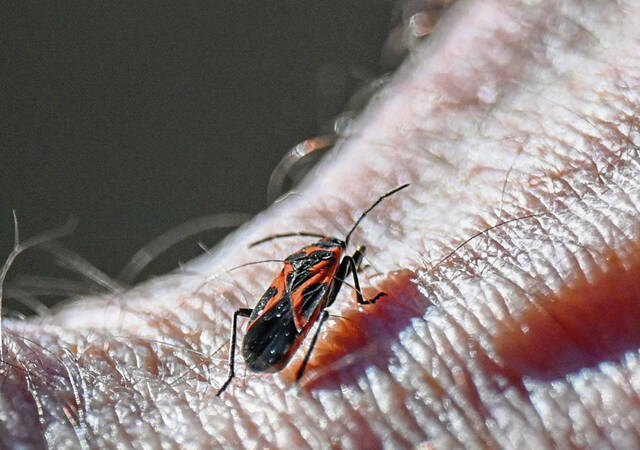Too warm: Plants, insects, people likely to pay the price for warm winters
The active milkweed bug Chris Kubiak found this week is not a good sign.
The harmless-to-humans bug was out and about at Beechwood Farms Nature Preserve in Fox Chapel, where Kubiak is director of education.
It, like most other insects native to the region, should be inactive, waiting out winter to wake up in the spring.
But unseasonably warm winter temperatures — a trend over the past few years — has lots of bugs active much earlier than normal. And that, Kubiak fears, could spell trouble this spring for humans and bugs alike.
“Overall, everyone likes the warm weather, but it’s going to have some very negative impacts in our ecosystems,” Kubiak said.
The average monthly temperature in January was 33 degrees, which is 4.2 degrees above normal, said Pittsburgh National Weather Service meteorologist Chris Leonardi. Twenty-one of 31 days in January were above normal, he said.
Last year was even warmer. The average monthly temperature in January 2023 was 36.9 degrees, with 28 of the 31 days being above normal, Leonardi said. He said, generally, winters have gotten warmer over the past 10 to 15 years.
“It’s been warmer more often than colder,” Leonardi said.
What people can do
With the mild winters and pleasantly warm temperatures, many insects are active that normally would be dormant still. When temperatures warm up, agricultural plants such as peaches, cherries and apples start pushing sap and flowers, thinking it’s spring.
But that makes them more susceptible when frosts and freezes happen. Early fruit blooms that sustain frost damage ultimately produce less fruit.
“Our ecosystems are critical for the health of human beings. When they are unhealthy, ultimately, it’s going to impact us,” Kubiak said.
Even evergreen trees are not immune to unseasonable warmups. Northern hemlocks, for example, shouldn’t be producing sap at this time of year, Kubiak said. But they are and that’s attracting woodpeckers that bore into the trees, looking for a high-energy snack.
The upshot is damage to the trees happening earlier and for longer than normal, reducing the tree’s chance of recovery.
Daffodils are also starting to sprout earlier, which is unusual, said Don Wolfe, who owns Wolfe Nursery in Hempfield.
Wolfe said that while bugs won’t have an impact on plants yet, he does advise people to spray dormant oil on their trees and shrubs. People should spray it at times during the day that provide time for it to dry before it freezes, he said.
Dormant oil works to control pests by suffocating them.
“That normally kills a lot of bugs before they are out of their egg mass,” he said.
Typically, dormant oil is sprayed in mid-March.
“This is very unusual this year,” Wolfe said. ”I haven’t seen it this warm in February and January that I can remember, so it is very new.”
Bug outlook
The overall outlook for bugs is impacted by climate change, said Rachel Handel, communications director for the Audubon Society of Western Pennsylvania. Warmer weather over the winter means more insects are surviving, and even extending, their ranges into areas where they did not previously live.
“This impacts the entire ecosystem,” Handel said.
For people, that means more bothersome insects this spring and summer like mosquitoes and ticks.
That trend of warmer weather has caused some bugs — such as the Lone Star tick — to migrate north, said Michael Skvarla, entomology professor at Penn State University.
“It’s impossible to tell with a single year. In the long term, as we see more and more mild winters, we’ll see insects migrate north and stay here,” Skvarla said.
Generally, most insects are dependent on temperature for development, said Nelson Milano, watershed coordinator at the Audubon Society of Western Pennsylvania.
“Warmer weather may boost the chances of survival during the winter, but factors such as cold exposure and lack of food could be detrimental,” Milano said.
“Unfortunately, warmer weather causes native, beneficial insects to wake up from diapause (the insect version of hibernation) and start being active again. That uses up any fat stores that would have originally helped keep them alive until food was available. Early pollinators like bumble bee queens may emerge before early spring flowers and starve if there are no nectar and pollen resources available,” Milano said.
While winter thus far has been mild, it’s still yet to be seen what that could mean for the upcoming bug forecast.
“The impact is going to depend on the weather and only impact a subset of insects,” Skvarla said.
Science behind the bug forecast
Overwintering insects have a few methods to survive the cold, Milano said.
“Death via freezing has more to do with the formation of ice crystals on the insect’s body rather than low temperatures,” he said. “Those ice crystals can form and expand quickly, and can cause the insect’s cells to burst and damage organs.”
To avoid that type of freezing, insects such as monarch butterflies migrate south to spend the winter.
Other insects are freeze tolerant, which means they can survive body fluid freezing and ice crystals on their body by producing ice nucleating proteins that control the freezing process, Milano said. Some have a freeze avoidant that prevents body fluid freezing with special carbohydrates that lower the freezing point of the body, so no ice crystals are formed.
“In general conversation, entomologists say insects that survive the winter produce their own antifreeze. This only works if the temperature drop is gradual, not a sudden cold snap,” Milano said.
Insects like the invasive hemlock woolly adelgid produce wax that keeps them from freezing in the winter. Warmer weather allows them to be active for longer to feed on hemlocks, which leads to the tree eventually dying.
Ticks and lanternflies
Ticks are a problem year-round.
“Even when it’s cold outside, ticks are around, and there’s the possibility that they will attach to a host,” Handel said. “During snowy weather, ticks can remain beneath the snow layer, which provides insulation and allows them to survive. And even if there’s no snow but it’s cold outside, ticks may hide beneath a layer of leaves for insulation.”
Adult ticks are active all winter, Skvarla said.
“People don’t usually think of ticks being an issue in winter, but black-legged ticks are active as long as it’s above freezing,” he said.
The Audubon Society recommends people always use caution when hiking in areas that could have ticks. Tips include tucking pant legs into socks, using tick repellent and doing a tick check when a hike is over. People also should check their pets for ticks.
“Unfortunately, ticks appear to be here to stay,” Handel said. “Whether we have a cold snap or a warm winter overall, ticks are something that we need to be vigilant about.”
Spotted lanternflies also will be here to stay this summer.
“Right now, the adults have died but they’ve left behind sub-zero-tolerant egg masses that overwinter on tree trunks and other surfaces,” Handel said.
The egg masses look like mud. She recommended people remove the mass and squish the eggs.
Spotted lanternflies can cause serious damage, including oozing sap, wilting, leaf curling and dieback in trees, vines, crops and many other types of plants, according to the state’s Department of Agriculture.
“In May, the eggs will begin to hatch, and we’ll see the now-familiar black-spotted first instar nymphs,” Handel said.
People should stomp on lanternflies when they see them. While dangerous to some plants, spotted lanternflies don’t hurt people or animals.
Last year, spotted lanternflies swarmed Western Pennsylvania.
“If they follow the same trend in the east, we’ll have another year where they’re bad and then it won’t be as bad as it has been,” Skvarla said.
Kellen Stepler is a TribLive reporter covering the Allegheny Valley and Burrell school districts and surrounding areas. He joined the Trib in April 2023. He can be reached at kstepler@triblive.com.
Remove the ads from your TribLIVE reading experience but still support the journalists who create the content with TribLIVE Ad-Free.






